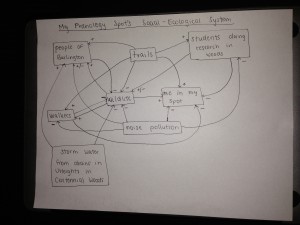1.) In terms of resource use, Centennial Woods has gone through much change over time. From its first encounters with human beings through present-day Burlington, the Woods have changed appearance dramatically. Additionally, the resources that human beings in the area have demanded from the Woods has changed over time. All of this history has had a hand in shaping the landscape into its current form today.
About one hundred fifty years ago, Centennial Woods was farmland. As the years passed, the farm was likely abandoned or transformed into something else. I have knowledge that the Woods was once an apple farm, as evidenced by some apple trees visible from the path near the entrance of the woods. These farms reveal that people used the soil there as a resource. They also likely used the water from Centennial Brook as irrigation for the fields, or at least benefitted from occasional flooding and soil enrichment.
Now, the land is used as a natural area. The resource is its wildlife and a getaway from the bustle of UVM and Burlington. Also, UVM students use Centennial Woods for research, so the biology of the Woods can be considered a resource currently in demand.
2.) Centennial Woods is owned by the University of Vermont and is deemed a natural area, meaning construction is not allowed, among many other restrictions. These regulations and rules are an example of institutions curbing human behavior in the space. I believe there have been efforts to remove invasive species from the Woods. This is an example of institutions regulating natural areas. In the future, perhaps the university will conduct various studies that alter the landscape, such as experimenting with forest structure. This human dominance over the forest has continued from the past, into the present, and likely into the future. The difference may be that now people are much more concerned about the health of the forest and are developing a greater respect for the environment and its functions.
